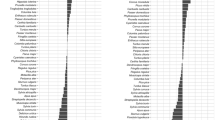Abstract
Nesting home ranges of individual birds were regularly mapped in 2013 and 2014 from May to July along a permanent census route (3.15 km) in the dark-coniferous taiga on the southern slope of the bed of Lake Baikal. Based on the mapping results, the nesting densities and average sizes of the nesting home range of individual birds are estimated for each bird species and raster maps of spatial allocation (MSAs) at a scale of the raster grid of 50 × 50 m are obtained for each species. The degree of spatial conservatism (DSC) for each local population is inferred from the pairwise comparisons of the specific MSAs obtained on the same area (31.5 ha) in different years with the use of the Gamma rank correlation method. The dependence of the population habitat area on the DSC was demonstrated earlier (Cherenkov, 2017). The larger habitat area is found within the sample plot, an a less dependent individual spatial allocation within a population is observed in different years. Based on the estimated specific habitat areas, average sizes of the individual nesting home range, and estimated nesting density, the maximum possible nesting density and habitat saturation are calculated for each species. The population status is inferred from the degree of habitat saturation. Significant DSC estimates (p < 0.05) are obtained for nine species; their habitat areas and saturation are found. It is shown that habitat saturation in nonmigratory birds is twice as high an in migratory ones. On average, habitat saturation was 54–58% in nonmigratory birds and 26% in migratory ones (F = 9.1; p < 0.01). In the two species, the orange-flanked bush-robin (Tarsiger cyanurus Pallas, 1773) and taiga flycatcher (Ficedula (parva) albicilla Pallas, 1811), the habitat saturation is less than 20%, which indicates the presumably troubled status of their populations.
Similar content being viewed by others
References
Baskakov, V.V., Razmeshchenie gnezdyashchikhsya ptits po biotopam i vysotnym poyasam khrebta Khamar-Daban (Location of Nesting Birds within the Biotopes and High-Altitudes of Khamar-Daban Ridge), Tankhoy: Baikal. Gos. Prirod. Biosfernogo Zapoved., 1981.
Baskakov, V.V., Letopis’ prirody (Chronicles of Nature), Tankhoy: Baikal. Gos. Prirod. Biosfernogo Zapoved., 1984–1987.
Cherenkov, S.E., An approach to evaluating ecological status of populations in forest-nesting birds (Passeriformes and Piciformes), Contemp. Probl. Ecol., 2017, vol. 10, no. 3, pp. 203–214.
Cherenkov, S.E., Faunistic composition, phenology, and nesting density of birds in dark coniferous forest on the northern slope of the Khamar-Daban Ridge, Russ. Ornitol. Zh., 2018, vol. 27, no. 1616, pp. 2503–2524.
Izmailov, I.V. and Borovitskaya, G.K., Ptitsy Yugo-Zapadnogo Zabaikal’ya (Birds of Southwestern Transbaikalia), Vladimir: Vladimirsk. Pedagog. Inst., 1973.
Kapitonova, L.V., Nesting of the Pallas’s leaf warbler Phylloscopus proregulus group and some aspects of nesting biology of the species in anthropogenic conditions of western macroslope of Bureinsky Ridge (Chegdomyn and Soloni settlements), Russ. Ornitol. Zh., 2015, vol. 24, no. 1114, pp. 773–782.
Koblik, E.A., Red’kin, Ya.A., and Arkhipov, V.Yu., Spisok ptits Rossiiskoi Federatsii (The List of Birds of Russian Federation), Moscow: KMK, 2006.
Kuzyakin, A.P., Registration methods of birds by time of migration, in Soveshchanie po voprosam organzatsii i ucheta resursov fauny nazemnykh pozvonochnykh (Meeting on Organization and Registration of Resources of Fauna of Terrestrial Vertebrates), Moscow, 1961, pp. 122–124.
Mel’nikov, Yu.I. and Gagina-Skalon, T.N., Birds of the Baikal Lake (from the end of 19th until beginning of 21st century): species composition, distribution, and habitat conditions, Byull. Mosk. O-va. Ispyt. Prir., Otd. Biol., 2016, vol. 121, no. 2, pp. 13–32.
Odum, E.P., Fundamentals of Ecology, Philadelphia: W.B. Saunders, 1953.
Priednieks, Ya., Kuresoo, A., and Kurlavichyus, P., Rekomendatsii k ornitologicheskomu monitoringu v Pribaltike (Recommendations for Ornithological Monitoring in the Baltic Region), Riga: Zinatne, 1986.
Pukinskii, Yu.B., Gnezdovaya zhizn’ptits basseina reki Bikin (Nesting Life of the Bikin River Basin), St. Petersburg: S.-Peterb. Gos. Univ., 2003.
Ravkin, Yu.S., Registration of the birds in forest landscapes, in Priroda ochagov kleshchevogo entsefalita na Altae (The Nature of Tick Encephalitis Foci in Altai Region), Novosibirsk: Nauka, 1967, pp. 66–75.
Sinyukovich, V.N. and Chumakova, E.V., Modern features of hydrometeorological regime of southern coast of the Baikal Lake, Izv. Irkutsk. Gos. Univ., 2009, vol. 2, no. 2, pp. 117–133.
Tomialojc, L., The combined version of the mapping method, in Bird Census Work and Nature Conservation, Oelke, H., Ed., Gottingen: Dachverband Dtsch. Avifaunisten, 1980, pp. 92–106.
Tyulina, L.N., Vlazhnyi pribaikal’skii tip poyasnosti rastitel’nosti (Humid Baikal Type of Zonality of Vegetation), Novosibirsk: Nauka, 1976, vol. 23 (43).
Vasil’chenko, A.A., Ptitsy Khamar-Dabana (Birds of the Khamar-Daban Ridge), Novosibirsk: Nauka, 1987.
Venttsel’, E.S., Teoriya veroyatnostei (The Theory of Probability), Moscow: Vysshaya Shkola, 1999.
Acknowledgments
The work would have been impossible without the organizational and friendly support of Deputy Director of Science of the Baikal Nature Reserve Yu.A. Anisimov. A researcher from the reserve, Valentina Anisimova, provided the materials of the “Chronicle of Nature.” Assistance in ensuring field works was provided by Natalya Gamova, Vladimir Yanin, Nikolai Korotkov, and Andrey Konovalov, as well as volunteers Olga Krivoshchapova (Russia, Moscow) and Line Grottian (Germany). A.V. Fil’chagov took the trouble to edit the article. We express sincere gratitude to everybody for their help.
Author information
Authors and Affiliations
Corresponding author
Additional information
Russian Text © The Author(s), 2019, published in Sibirskii Ekologicheskii Zhurnal, 2019, No. 3, pp. 285–292.
Rights and permissions
About this article
Cite this article
Cherenkov, S.E. Ecological Status of Populations of the Most Common Bird Species in the Dark-Coniferous Taiga of Baikalia. Contemp. Probl. Ecol. 12, 231–237 (2019). https://doi.org/10.1134/S199542551903003X
Received:
Revised:
Accepted:
Published:
Issue Date:
DOI: https://doi.org/10.1134/S199542551903003X




